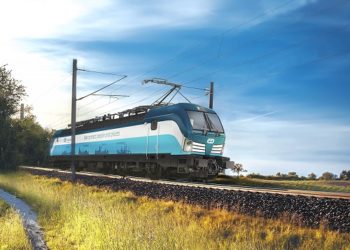Czech national operator České Dráhy has begun using ComfortJet long-distance trainsets on the Berliner international service from Praha to Berlin. This follows their entry into service on domestic routes in June.
‘We are symbolically starting a new phase of putting our most modern train on the tracks’, said ČD Chairman & Director General Michal Krapinec after the first public working to Berlin on September 29. ‘We currently have four trains of eight carriages ready for operation, which are now running not only to Germany, but also in one case to Slovakia.’
The ComfortJet push-pull trains are from Siemens Mobility’s Vectouro platform, based on the Viaggio Comfort trainsets originally developed for Austrian Federal Railways’ Railjet services. They are being produced with Czech partner Škoda Group which is fitting out the cars in Ostrava.
‘ComfortJet is an entirely central European project, with its individual parts being built in the Czech Republic, Germany and Austria’, said Czech Transport Minister Martin Kupka.
The trains are approved for operation in the Czech Republic, Germany, Poland, Austria, Slovakia, Hungary and Denmark, with fire protection and emergency brake override systems to enable operation in very long tunnels.
Michael Peterson, Chairman of DB Fernverkehr which operates the Berlin services with ČD, said ‘ComfortJet is a genuine European train. With three power supply systems and permits in seven countries, it can connect Graz and Budapest in the south, as well as Praha with Berlin and Hamburg in the north. In the future, it will even go as far as København.’
He said ’more co-operation in international long-distance transport is a central element of DB’s objectives for 2027’.
Three ComfortJet coaches were on show at InnoTrans, where Siemens Mobility told Railway Gazette International that they reflect ‘traditional railway engineering’ for flexibility and ease of maintenance, including standalone vehicles with the ability to re-form or lengthen trainsets.
There are push-button operated external doors with a selective locking system. Internal features include wide permanently open gangways, and photocell-activated automatic sliding doors between saloons and vestibules. The trains are pressure-tight to protect passengers from ear discomfort in tunnels or caused by passing trains going in an opposite direction, while helping to create a quiet and clean interior.
First class has adjustable leather-covered seats arranged 2+1. Second class has 2+2 seating with textile covers in a mix of airline and facing configurations, with folding or fixed tables.
Individual reading lights are integrated into the overhead shelves for small luggage, and there are racks for larger items.
There is wi-fi and an onboard infotainment portal, 230 V sockets and USB C-type connectors, as well as wireless mobile phone chargers in first class. The windows are designed to allow mobile phone signals to pass while maintaining the thermal insulation properties of the glass, and there are retractable sun blinds.
Features for accessibility include three wheelchair spaces with folding tables, an accessible toilet, electric lifting platforms, sockets for recharging electric wheelchair batteries, haptic buttons, Braille signs and a radio remote control door for blind people.
There is a children’s cinema, children’s board games, a folding counter for changing nappies, places to store prams. There is space for 12 bicycles, including sockets for the charging electric bike batteries.
The Praha – Berlin trains are operating in a temporary eight-car configuration without a driving car and with an older WRmz815 dining car. In the final configuration the trains will have a have a driving car with a cab identical to the Vectron locomotive at the other end, almost eliminating the need for separate driver training, plus an 18-seat ComfortJet dining car offering hot or cold meals.
A specific Czech request was the provision of taps to dispense two different types of beer.
(Railway Gazette International)















































